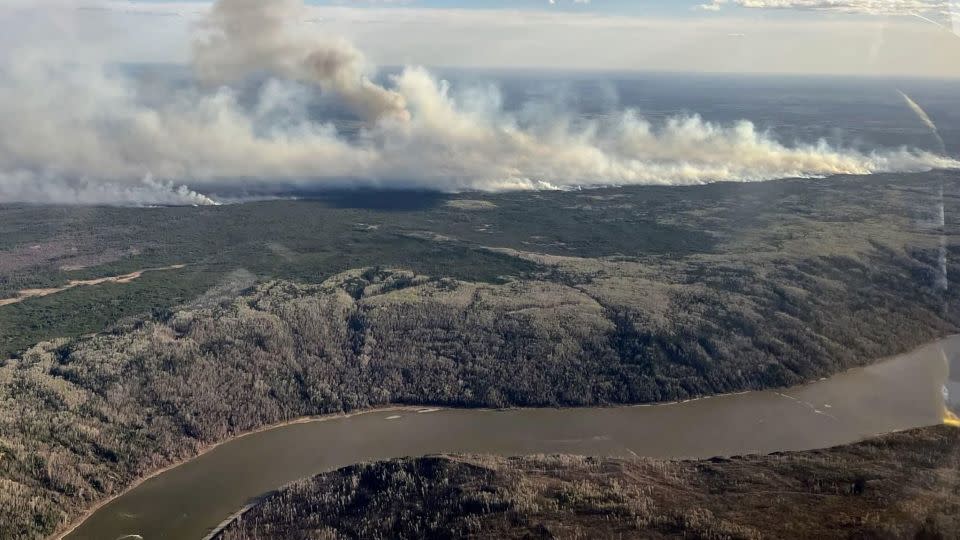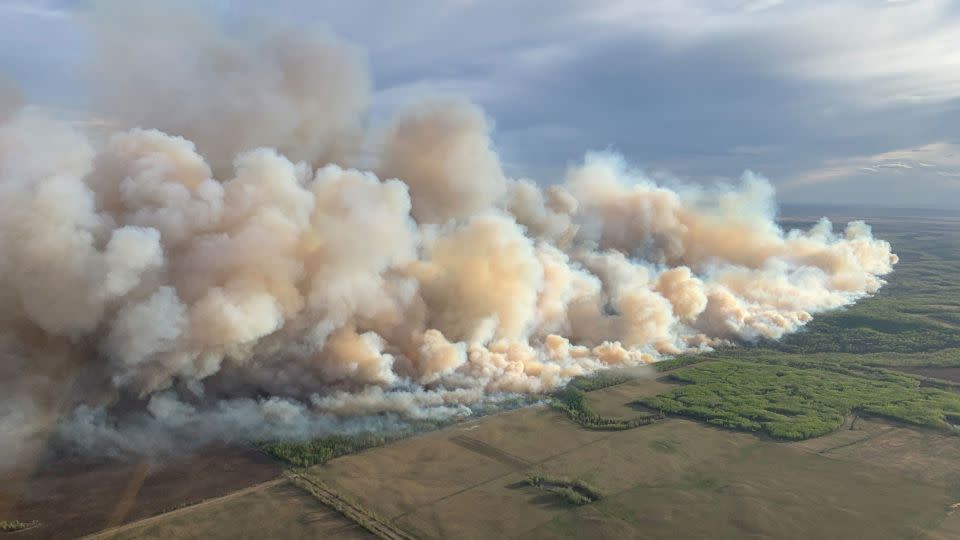Dozens of blazes burning in Canada are sending smoke to the US. Several major fires have forced hundreds of evacuations
More than 100 blazes are burning across Canada Monday, with several major wildfires prompting evacuations for hundreds of residents and threatening to swallow up communities.
In the province of Manitoba, in eastern Canada, a massive fire had charred more than 86,000 acres by Monday evening and was less than a mile away from the community of Cranberry Portage, local authorities said. More than 500 residents there had been evacuated, according to Manitoba officials.
“I’ve been working in wildfires for 40 years, I’ve never seen a fire move like this fire moved,” Manitoba Wildfire Service Director Earl Simmons said in a Monday news conference.
In Western Canada, the Parker Lake Fire in northeastern British Columbia more than tripled in size over the weekend to 13,000 acres and is now on the doorstep of the small community of Fort Nelson. The blaze was less than 1.5 miles west of the town Monday morning, and gusty winds are expected to linger in the coming days and could bring the flames even closer.
“The next 48 hours will be a challenging situation,” said Bowinn Ma, BC minister of emergency management and climate readiness. “We may begin to see volatile wildfire activity later this afternoon.”
As of Monday morning, roughly 4,700 people were under evacuation orders, including in the town of Fort Nelson and Fort Nelson First Nation, Ma said. People across 80 other properties were also asked to evacuate, the official added.
Evacuation alerts are also in effect for parts of Alberta as wildfire MWF-017 burns about 10 miles southwest of the city of Fort McMurray – an area that was devastated by a wildfire in 2016. By Monday evening, that blaze had grown to more than 16,200 acres.
An evacuation alert was issued for residents in Fort McMurray, Saprae Creek, Gregoire Lake Estates, Fort McMurray 468 First Nation and Anzac, according to Alberta officials.
The blazes also prompted the Canadian National Railway Company to suspend services in some areas.
“CN has suspended service on our network between Fort St. John and Fort Nelson in British Columbia and north of High Level, Alberta due to wildfire activity,” spokeswoman Ashley Michnowski told CNN. “We are working with impacted customers as our crews assess damages and identify any required repairs.”
Warming climate helps fire conditions
Extremely dry conditions and winds gusting up to 25 mph are driving the fire Monday, but the seeds of fire activity were sown over the winter and in past years as the world continues to warm because of human-driven climate change.
“This region has experienced multiple years of drought, with a below normal snowpack this past winter,” said Ben Boghean, fire behavior specialist for the BC Wildfire Service. “As a result of this, our forests in the Fort Nelson zone are very receptive to new fire ignitions and rapid rates of spread.”

Declining snow, increasing temperatures and worsening droughts are all hallmarks of climate change and are projected to keep driving larger and more intense fires across Canada, according to Environment Canada.
Last year was Canada’s most devastating fire season on record, including in British Columbia, where fires burned through hundreds of homes and an area the size of Maryland, according to the BC Wildfire Service.
The Parker Lake Fire is not alone. There are more than 100 fires burning across Canada, 39 of which are considered out of control, according to the Canadian Interagency Fire Centre.
Some of the blazes are so-called “holdover fires” also known colloquially as “zombie fires,” the smoldering remains of last season’s epic blazes, burning deep in the ground throughout the winter and reigniting when exposed to warmer temperatures in the spring.

“In the past, the winter conditions are what put out a lot of holdover fires,” Ma said. “In this case, what we’ve seen is that due to higher temperatures and persistent drought through the last year, many of these holdover fires were not put out like they normally are.”
Two “zombie” fires, the Patry Creek Fire and the Nogah Creek wildfire, are growing rapidly to the north and east of Fort Nelson and contributing to the evacuation orders.
Evacuation alerts are also in place for parts of Alberta as the MWF-017 wildfire burns out of control near Fort McMurray in the northeastern area of the province, officials said. The fire had burned about 16,000 acres as of Sunday morning.
Hazardous smoke creeps into the US
Smoke from the infernos has caused Environment Canada to issue a special air quality statement extending from British Columbia to Saskatchewan.
It has also caused smoke to waft down into the northern tier of the US for the first time this year, and for air quality alerts to be issued for Wisconsin, Minnesota and Iowa. Air quality reached “unhealthy” levels in all three states Monday, including Minneapolis-St. Paul, according to AirNow.gov.
On Monday afternoon, the Twin Cities had the eighth-worst air quality of 119 major cities tracked by IQAIR, a company tracking air quality worldwide.
Particulate matter levels this high can cause issues for sensitive groups or anyone spending prolonged time outdoors, according to the Environmental Protection Agency. Wildfire smoke has been linked to increases in certain cancers and heart-related issues, among other ailments.
Just last year, smoke from Canadian wildfires made its way to parts of the United States and caused dangerous air conditions across the country. In 2023, 19 counties in 11 states had days with “very unhealthy” and “hazardous” air quality — given at least a “code purple” alert on the US Environmental Protection Agency’s Air Quality Index.
Poor air quality conditions are expected to linger in the US through Monday, and likely longer in parts of Canada closer to the fires, including Alberta and British Columbia.
Canadian officials warned those at higher risk of experiencing health effects from wildfire smoke include people with lung disease such as asthma, people with heart disease, along with older adults, children, those who are pregnant and people who work outdoors. They also recommended those who spend time outdoors wear a mask to help reduce exposure to fine particles of smoke.
For more CNN news and newsletters create an account at CNN.com

